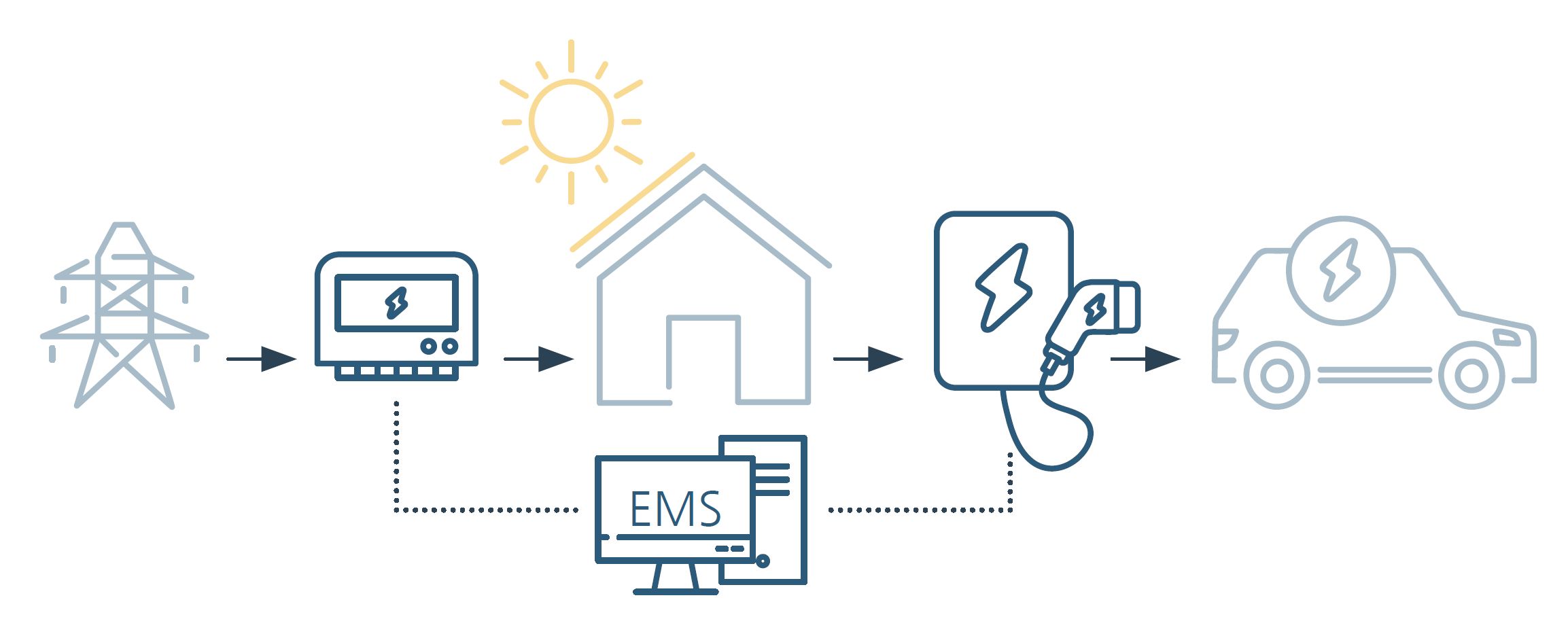Press Release #13
“Wallbox Inspektion” Project Develops First Quality Standard for Wall Chargers
Wall chargers for charging electric vehicles can be found on more and more homes. But how can the solar power from your own roof be used as smartly as possible? In the “Wallbox Inspektion” project, a consortium consisting of Fraunhofer Institute for Solar Energy Systems ISE, HTW Berlin and ADAC e.V. developed the first test procedure for solar-optimized controlled charging and used it to test wall chargers available on the market. Together with an industry advisory board, a test guideline for unidirectional and solar charging was developed and the test results are quantified in a score that is easy to understand for end users. The intention is to increase transparency for consumers in the wall chargers market and establish a quality standard for the industry. The project was funded by the Federal Ministry for Economic Affairs and Climate Protection.
By 2030, millions of electric vehicles are expected on German roads, many of which will be charged at wall chargers. Currently, 53 percent of charging processes take place at home, especially among owners of a photovoltaic system: 93 percent use a wall charger to charge their electric vehicle with their own electricity. It is also possible to benefit from time-variable electricity prices by adapting the operation of the wall charger accordingly. The “Wallbox Inspektion” project is investigating how this can be regulated as precisely and economically as possible. Wall charger solutions from various manufacturers were tested under identical and realistic operating conditions in the Digital Grid Lab at Fraunhofer ISE.
In addition to power consumption during operation and standby mode, the tests focused on control quality and operating effects, which play a central role in the solar charging of electric vehicles. The main focus there is on how a solar surplus can be stored in an electric vehicle as efficiently as possible and how it is possible to switch between 1-phase and 3-phase operation at low power levels.
Charging station behavior tested realistically
The tests developed in the project evaluated the flow of electricity between photovoltaic system, household, power grid and electric vehicle. The researchers measured the maximum charging current that the wall charger communicated to the vehicle. This value can be used to control the vehicle’s power consumption according to the solar supply. The maximum available current is the solar generation that remains after deducting the electricity required in the household.
The energy management system – integrated into the charging station or the energy meter- monitors the grid connection via the energy meter and controls the electric vehicle via the wall charger. No real vehicles were used to test the charger, but rather the digital vehicle twin “ev twin” from Fraunhofer ISE, which can simulate the behavior of 5,000 different electric cars. This offers the advantage that no vehicle has to be driven to discharge it after the test. Instead, the power flow is emulated with bidirectional power supply units. Another advantage: the influences of different charge controllers in the vehicles are eliminated.
The team tested the response behavior of the wall charger in specific realistic situations, such as standby mode and various large jumps in the solar system’s output. “A fast control speed with the high control quality is crucial for solar-controlled charging. In practical operation, this means that the control by the charging station follows the solar surplus as closely as possible”, explains Dr. Bernhard Wille-Haussmann, project manager “Wallbox Inspektion”.
Tests results should increase transparency in the market
The wall chargers reacted at different speeds to changes in the solar power supply: while some adjusted the charging power immediately, others had a delay of up to 90 seconds. The devices also showed different behaviour in standby mode: some into a reduced (deep standby) mode to save power.
However, it has also been shown that the energy management system of many wall chargers must be adapted to ensure good control quality: The researchers generally recommend that users of wall chargers adjust the device to the vehicle and their own needs. “The devices then work more precisely than with standard settings. The differences between the devices of the various manufacturers are then also reduced. The characteristics of your own energy management system play a major role”, explains Dr. Bernhard Wille-Haussmann.
Based on the measurement results, the Berlin University of Applied Sciences creates a score that quantifies the differences in quality between the products. The basis for this score are simulations based on measurements in accordance with the test guidelines. ADAC e.V. uses the results from the project to advise consumers.
The project team also wants to use the transparent and uniform measurement procedure and the measurement results to show manufacturers specific optimization potential with regard to the quality and energy efficiency of their devices. The results will show consumers and installers which parameter settings lead to good solar energy utilization.
The project team invites all interested charging station manufacturers and system integrators to the “Wallbox Inspection” workshop on Thursday, May 8, as part of “The Smarter E” in Munich. It presents the test guidelines developed in the project and uses specific examples to discuss the results in terms of good solar utilization.
More information and registration:
https://www.ise.fraunhofer.de/de/anmeldung/workshop-wallbox-inspektion.html
The test guide will be available on this website from May 8:

Last modified: